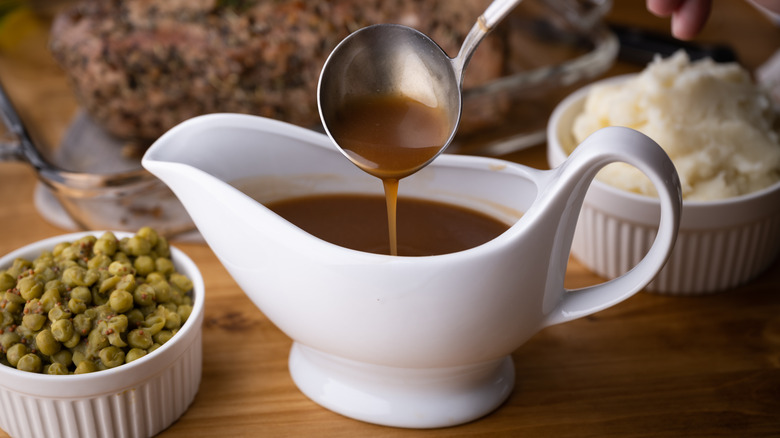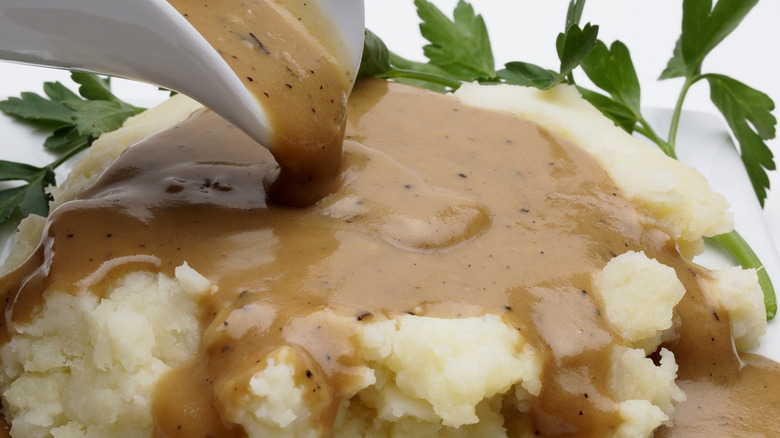How To Save Gravy That's Way Oversalted
Some cooking mistakes are easy to fix. Others, maybe not so much. If something is bland, you can add more seasoning, but if you've gone overboard with seasoning, that's much trickier to undo. You want your gravy to be flavorful, especially if it is to be poured over foods that are usually milder in flavor, such as basic meat and potatoes. But an excessively salty gravy is a surefire way to ruin everything else on your plate.
The most common tip for fixing over-salted foods, which you've probably heard before, is to add chunks of chopped potato to soak up that extra sodium. It turns out, though, that this supposed trick is more of an old wives' tale than real kitchen science. The potatoes will soak up some salt, sure, but they won't reduce the proportion of salt in gravy, soups, stews, or sauces. You'll end up with salty, gravy-flavored potato chunks, but the gravy itself probably won't taste any different.
Fortunately, there is hope for gravy that tastes like the ocean, but it doesn't involve any magic salt-sponging ingredients. What you essentially need to do is dilute the amount of salt by increasing the volume of other, non-salt ingredients.
No need to stay salty
To balance out the excess salt, what you'll need to do is make more gravy. So break out another saucepan and repeat the first few steps of the gravy-making process in the new vessel. It's a bit more work than just dropping in some potato chunks, but making the extra effort can save your gravy from sodium-laden doom.
Start by making a roux, then add your stock of choice (chicken, beef, vegetable, what have you). What you'll create is a small pot of seasonless, unsalted gravy. Add some of the bland gravy to the salty one, just a spoonful or two at a time, until the original gravy tastes the way you want it to.
The addition of the unseasoned gravy increases the total volume of gravy and thereby decreases the amount of salt in each spoonful. You're increasing the ratio of gravy to everything else in the pot, so the quantity of salt it already contains goes from excessive to appropriate. This basic principle applies when trying to fix any kind of over-salted liquid — the surest way to get the taste back on track is to dilute the salt by adding more of the other ingredients to whittle down the proportion.
Of course, this method does increase your total volume of gravy, possibly providing way more than you need — but that's still probably less wasteful than dumping the whole pot and completely starting over.
When less is more
If you don't want to end up with more gravy than you think you can use, there is another method to fix a salty sauce that some cooks swear by: Increase a different strong flavor to compete with the salt. Adding some extra acidity, in the form of vinegar or lemon juice, may be enough to mask the excess salt. Alternatively, you can try adding extra fat by pouring in some cream or butter. In some cases, you may even want to add sugar to counteract the saltiness.
The idea behind these additions is to make the saltiness less perceptible by turning up the volume on a different flavor, but you should know that there's no guarantee that the trick will work. It is a method that typically works best if the gravy is only slightly over-salted and a small adjustment might provide the balance you're looking for. But be warned, you might just end up with a gravy that's not only too salty, but weirdly citrusy, creamy, or sweet. Experiment as you please, but your safest bet is going to be diluting the concentration of salt by increasing the volume of other ingredients. Don't worry about making so much gravy that some goes to waste – you can freeze the extra.


